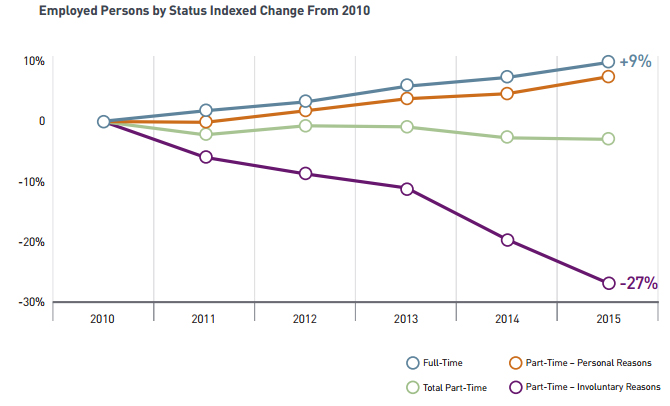Contrary to predictions, many companies did not eliminate jobs with the advent of ObamaCare, the Affordable Care Act.
ADP, the payroll management company, has issued a report showing on the whole, companies employing 50 or more full-time workers, have not reduced employee hours to avoid the expense of health care benefits.
ADP said as recently as a year ago, nearly 40 percent of these companies said they planned to reduce worker hours to fewer than 30 or move them into other hourly categories.
They didn’t, the report said.
If employers reduced hours to keep employees below the 30-hour threshold, one would expect to see an increase in part-time jobs but with fewer hours worked per job. However, data from the U.S. Bureau of Labor Statistics (BLS) shows a 9% increase in full-time jobs from 2010 to 2015, while the total number of part-time jobs decreased slightly.
Employment data from the ADP Workforce Vitality Index shows the part-time workforce grew more slowly (2.7%) than the full-time workforce (3.8%) between the first quarter of 2014 and the first quarter of 2015.
The study found there was no change in the number of hours worked in each of the employee categories.
But the researchers note that the impact of the healthcare law may be “cloaked” in an improving economy.
As the ACA went into effect, the U.S. economy has began to recover from recession, resulting in more full-time opportunities for employees who previously had only been able to obtain part-time positions. Data from the Bureau of Labor Statistics (BLS) shows a 9% increase in full-time jobs from 2010 to 2015, while the total number of part-time jobs decreased
slightly.Additionally, when the total number of part-time workers is split into two categories — those who choose to work part-time for convenience or personal reasons and those who work part-time involuntarily while seeking full-time work — the number of involuntary part-time workers fell by 27%.
In North Dakota, for example, its like old times, according to an article today in the Fargo Forum.
North Dakota is one of the 10 states that has experienced the greatest reduction in the rate of those who are not covered by health insurance from 2013 to 2015, according to a survey from Gallup.
And more employers are providing health benefits. Why? Because they’re having a hard time attracting workers in an expanding economy.
Besides expansion of health insurance through the Affordable Care Act, the strong economy in North Dakota has helped broaden coverage, according to Sandene and Pat Bellmore, chief marketing officer for Blue Cross Blue Shield of North Dakota.
The North Dakota Blues have seen more employers provide health insurance for the first time, Bellmore said.
“A lot of it is the tight labor market,” he said. To attract and keep workers, employers must offer competitive benefits, including health insurance, Bellmore added.
But some companies still live in a take-it-or-leave-it economy with their workers. Some employers are cutting back on the quality of the health benefits they offer, a new analysis says, moving employees into high-deductible health plans to discourage workers from actually seeking health care.

